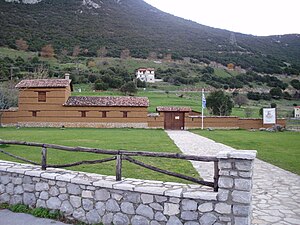Battle of Gravia
| date | May 8, 1821 |
|---|---|
| place | Gravia , Greece |
| output | Victory of the Greeks |
| consequences | Retreat of the Ottomans to the island of Evia |
| Parties to the conflict | |
|---|---|
|
Greek armatoles |
|
| Commander | |
| Troop strength | |
| approx. 120 | approx. 9,000 |
| losses | |
|
approx. 6 dead |
approx. 300 dead |

The Battle of Gravia , also known as the Battle of the Caravanserai of Gravia , was part of the Greek Revolution and took place on May 8, 1821 between Greek rebels and the Ottoman Empire . The Greek leader Odysseas Androutsos inflicted great losses with a group of around 120 men in the Ottoman army under the leadership of Tosken Omer Vrioni, which consisted of around 9,000 soldiers including artillery .
background
After the victorious Battle of Alamana against Greek revolutionaries and the subsequent execution of freedom fighter Athanasios Diakos in May 1821 Ottoman leader Omer Vrioni decided from his base in the town of Lamia in with an army of 9,000 men and artillery in the southern Peloponnese to go to put down the local Greek rebellion as well. In response, the independence fighter Odysseas Androutsos and about 120 followers barricaded themselves in an old walled inn in the village of Gravia, near the road used by the Ottomans.
Two other leaders named Panourgias and Duovounitis, who had also come with Androutsos, took up positions on the other side of the street in an elevated position. They presumably did so in the expectation that Odysseas Androutsos' scheme would end in a similar Greek disaster as the Battle of Alamana; the elevated position would have made it easier to retreat . When the Ottoman Vrioni arrived in the village, he distributed his troops on the surrounding hills to surround the caravanserai . He also sent a dervish to negotiate with Androutsos, but he was shot at the door. Then Omer Vrioni ordered the attack on the house.
Course of the battle
Following the order to attack, a unit of Albanian soldiers attempted to storm the inn, but were taken under heavy fire after entering the building. With the continued fire of the hidden Greeks, the Albanians suffered great losses and were forced to retreat. Further attempts by the Ottomans to take the court ended in the same way.
When night fell, Vrioni ordered the cannons to be positioned in response to the casualties . However, Androutsos seemed to have foreseen this. During a break in combat due to the formation of the artillery, he and his fighters retreated and escaped undetected through the Ottoman lines. The Greeks only left about six dead compatriots behind.
consequences
The casualties of Vrioni's troops were severe: around 800 soldiers were wounded and around 300 killed in one day. The Ottoman leader retreated to the island of Evia off the coast of Attica , where he later united his army with that of Kioshe Mehmet.
The Battle of Gravia is particularly important in Greece within the Greek Revolution. Vrioni's retreat gave the resistance fighters in the Peloponnese more time to gather their strength and then to take the Ottoman capital of the Peloponnese, Tripoli .
Today, on the site of the Gravia caravanserai, there is a replica of the building that housed a museum. Opposite the museum are the grave of Odysseas Androutsos and a monument with the names of 117 armatoles who fought with him in the inn.
literature
- Peter H. Paroulakis: The Greeks: Their Struggle for Independence . Hellenic International Press, 1984, ISBN 0-9590894-0-3 .
Individual evidence
- ↑ Hani Gravias greece.terrabook.com
